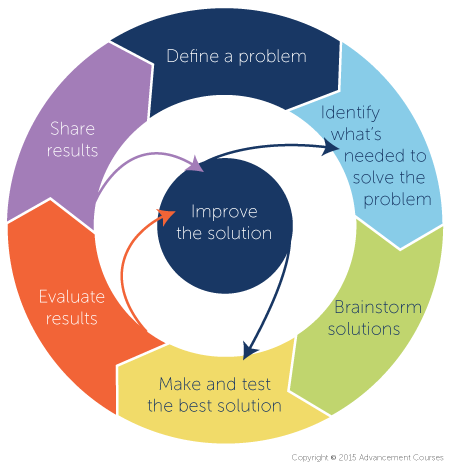In STEM education, engineering—the process of designing, building, and using engines, machines, and structures—is often ignored even though it is the key to authentic STEM instruction. For some teachers, engineering is intimidating as it’s rarely mentioned in science, math, or technology teacher preparation. For others, it’s daunting. It seems like a lot of planning to successfully implement an engineering design project, which is not essential to science, math, or technology instruction.
Why STEM Teaching Matters?
The key to successful STEM teaching is the integration of science, math, and technology. In STEM careers, scientists don’tonly do science and applied mathematicians don’t only do math, instead they work across disciplines. So, to mirror the work of STEM professionals and increase college and career readiness, it’s important that students experience real-world, integrated projects in the classroom. Engineering bridges all of the STEM disciplines and provides students with authentic opportunities to think and act like engineers and scientists. Plus, it’s fun!
In engineering, students:
- Access and synthesize prior knowledge in science, math, and technology to solve a real-world problem
- Research and collect evidence to solve a problem
- Gain firsthand experience on how science, math, and technology solve problems in the real world
- Conceptualize, build, and test concrete models of solutions
- Work collaboratively to critique and build on their peers’ ideas
- Communicate and defend solutions based on evidence
Engineering design projects are, by nature, hands-on, creative, problem-solving activities, which your students will remember for years to come. Best of all, engineering allows all students to be successful. Girls and minorities—who are more likely to lose interest in science, math, and technology by the time they reach middle school—gain confidence when completing engineering design projects, while learning about STEM careers and topics that may interest them.
How to Get Started
To engage your students in engineering, the only prerequisite is a desire to lead your students on problem-solving adventures. There are no “right” designs. Every student may attack a problem differently and projects may or may not be successful. The end result, however, is that your students will be engaged, apply their learning in creative ways, develop problem-solving skills, and be excited about learning!
To help you design an engineering project, here are four important steps to keep in mind:
1) Define a Problem
The first step is to define a real-world problem that meets your standards and content requirements, interests students, and has many grade appropriate pathways to success. The problem can lead to a process or a product solution (e.g., what is the best way to purify a large water source or design a shoe that “grows” with a child) as both are integral to the work of engineers.
2) Identify What Is Needed (i.e., Performance Criteria) to Solve the Problem
What do you want your students to be able to do before, during, and after the engineering design project? If students are designing a process for purifying a large water source, they must know the physical and chemical properties of water and solutions; be able to work collaboratively to design, test, and re-design a process based on their prior and new knowledge; and present and defend their findings to their peers.
Engineering projects ask students to look past content knowledge and towards the process of doing science and math and choosing appropriate technology. There should also be a focus on collaborative skills, metacognition (self-thinking and regulation), resiliency, and perseverance. Once you have chosen your performance criteria, you can design processes, rubrics, and checklists that you will share with students at the beginning of each project.
3) Design Activities
This is where it’s time to get creative! You’ve come up with a great, engaging problem and you know what you are looking for, so it’s time to backwards design . Ask yourself these questions when designing your project:
- What is the problem?
- What STEM standards (NGSS, CCSSM, ISTE) does this problem align with?
- What background information do students need to solve the problem?
- What types of constraints will the students have (i.e. time, material, budget, etc.)?
- How will students work together to solve the problem?
- How will students test, gather data, and evaluate their products/solutions before redesigning?
- How will students share their results?
4) Train Student-Engineers
As with any new procedure in the classroom, it’s important to take the time to train students before beginning an engineering design project. It’s also crucial to allow time for students to test their solutions, collaborate and communicate with each other, and make necessary revisions to their solutions. Here are some final tips:
- Share expectations and create ground rules for group work (e.g., appropriate use of time, how to set up and clean up a project, how to communicate effectively within the group, etc.).
- Assign student roles for group work and provide students with ample time to practice their roles.
- Incorporate time in the project for students to test their solutions, share their test results with their peers, answer questions, and receive constructive criticism on their design, all of which are vital actions and roles of scientists and engineers.
- Allow time for students to modify and improve their solutions based on their test results and peer feedback. Engineers are constantly working with each other to tweak and refine projects. In fact, a failure in many cases is just one step to a better solution!
- Print out and showcase the Engineering Design Cycle created by Advancement Courses in your classroom. When your students have a question about the next step in the engineering design process, you can quickly reference the cycle without sacrificing sacred class time!

Implementing engineering in your classroom instruction will take some time and a shift in your practice, but it has the value of transforming your teaching practice by engaging students in the real work of engineers and scientists. You’ll love seeing how excited your students get about their learning and they will love it, tool.







